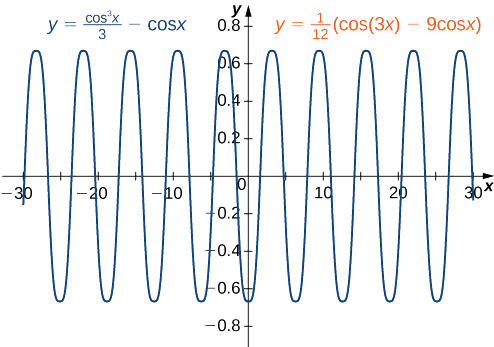7.5: Otras estrategias para la integración
- Page ID
- 116357
\( \newcommand{\vecs}[1]{\overset { \scriptstyle \rightharpoonup} {\mathbf{#1}} } \)
\( \newcommand{\vecd}[1]{\overset{-\!-\!\rightharpoonup}{\vphantom{a}\smash {#1}}} \)
\( \newcommand{\dsum}{\displaystyle\sum\limits} \)
\( \newcommand{\dint}{\displaystyle\int\limits} \)
\( \newcommand{\dlim}{\displaystyle\lim\limits} \)
\( \newcommand{\id}{\mathrm{id}}\) \( \newcommand{\Span}{\mathrm{span}}\)
( \newcommand{\kernel}{\mathrm{null}\,}\) \( \newcommand{\range}{\mathrm{range}\,}\)
\( \newcommand{\RealPart}{\mathrm{Re}}\) \( \newcommand{\ImaginaryPart}{\mathrm{Im}}\)
\( \newcommand{\Argument}{\mathrm{Arg}}\) \( \newcommand{\norm}[1]{\| #1 \|}\)
\( \newcommand{\inner}[2]{\langle #1, #2 \rangle}\)
\( \newcommand{\Span}{\mathrm{span}}\)
\( \newcommand{\id}{\mathrm{id}}\)
\( \newcommand{\Span}{\mathrm{span}}\)
\( \newcommand{\kernel}{\mathrm{null}\,}\)
\( \newcommand{\range}{\mathrm{range}\,}\)
\( \newcommand{\RealPart}{\mathrm{Re}}\)
\( \newcommand{\ImaginaryPart}{\mathrm{Im}}\)
\( \newcommand{\Argument}{\mathrm{Arg}}\)
\( \newcommand{\norm}[1]{\| #1 \|}\)
\( \newcommand{\inner}[2]{\langle #1, #2 \rangle}\)
\( \newcommand{\Span}{\mathrm{span}}\) \( \newcommand{\AA}{\unicode[.8,0]{x212B}}\)
\( \newcommand{\vectorA}[1]{\vec{#1}} % arrow\)
\( \newcommand{\vectorAt}[1]{\vec{\text{#1}}} % arrow\)
\( \newcommand{\vectorB}[1]{\overset { \scriptstyle \rightharpoonup} {\mathbf{#1}} } \)
\( \newcommand{\vectorC}[1]{\textbf{#1}} \)
\( \newcommand{\vectorD}[1]{\overrightarrow{#1}} \)
\( \newcommand{\vectorDt}[1]{\overrightarrow{\text{#1}}} \)
\( \newcommand{\vectE}[1]{\overset{-\!-\!\rightharpoonup}{\vphantom{a}\smash{\mathbf {#1}}}} \)
\( \newcommand{\vecs}[1]{\overset { \scriptstyle \rightharpoonup} {\mathbf{#1}} } \)
\( \newcommand{\vecd}[1]{\overset{-\!-\!\rightharpoonup}{\vphantom{a}\smash {#1}}} \)
\(\newcommand{\avec}{\mathbf a}\) \(\newcommand{\bvec}{\mathbf b}\) \(\newcommand{\cvec}{\mathbf c}\) \(\newcommand{\dvec}{\mathbf d}\) \(\newcommand{\dtil}{\widetilde{\mathbf d}}\) \(\newcommand{\evec}{\mathbf e}\) \(\newcommand{\fvec}{\mathbf f}\) \(\newcommand{\nvec}{\mathbf n}\) \(\newcommand{\pvec}{\mathbf p}\) \(\newcommand{\qvec}{\mathbf q}\) \(\newcommand{\svec}{\mathbf s}\) \(\newcommand{\tvec}{\mathbf t}\) \(\newcommand{\uvec}{\mathbf u}\) \(\newcommand{\vvec}{\mathbf v}\) \(\newcommand{\wvec}{\mathbf w}\) \(\newcommand{\xvec}{\mathbf x}\) \(\newcommand{\yvec}{\mathbf y}\) \(\newcommand{\zvec}{\mathbf z}\) \(\newcommand{\rvec}{\mathbf r}\) \(\newcommand{\mvec}{\mathbf m}\) \(\newcommand{\zerovec}{\mathbf 0}\) \(\newcommand{\onevec}{\mathbf 1}\) \(\newcommand{\real}{\mathbb R}\) \(\newcommand{\twovec}[2]{\left[\begin{array}{r}#1 \\ #2 \end{array}\right]}\) \(\newcommand{\ctwovec}[2]{\left[\begin{array}{c}#1 \\ #2 \end{array}\right]}\) \(\newcommand{\threevec}[3]{\left[\begin{array}{r}#1 \\ #2 \\ #3 \end{array}\right]}\) \(\newcommand{\cthreevec}[3]{\left[\begin{array}{c}#1 \\ #2 \\ #3 \end{array}\right]}\) \(\newcommand{\fourvec}[4]{\left[\begin{array}{r}#1 \\ #2 \\ #3 \\ #4 \end{array}\right]}\) \(\newcommand{\cfourvec}[4]{\left[\begin{array}{c}#1 \\ #2 \\ #3 \\ #4 \end{array}\right]}\) \(\newcommand{\fivevec}[5]{\left[\begin{array}{r}#1 \\ #2 \\ #3 \\ #4 \\ #5 \\ \end{array}\right]}\) \(\newcommand{\cfivevec}[5]{\left[\begin{array}{c}#1 \\ #2 \\ #3 \\ #4 \\ #5 \\ \end{array}\right]}\) \(\newcommand{\mattwo}[4]{\left[\begin{array}{rr}#1 \amp #2 \\ #3 \amp #4 \\ \end{array}\right]}\) \(\newcommand{\laspan}[1]{\text{Span}\{#1\}}\) \(\newcommand{\bcal}{\cal B}\) \(\newcommand{\ccal}{\cal C}\) \(\newcommand{\scal}{\cal S}\) \(\newcommand{\wcal}{\cal W}\) \(\newcommand{\ecal}{\cal E}\) \(\newcommand{\coords}[2]{\left\{#1\right\}_{#2}}\) \(\newcommand{\gray}[1]{\color{gray}{#1}}\) \(\newcommand{\lgray}[1]{\color{lightgray}{#1}}\) \(\newcommand{\rank}{\operatorname{rank}}\) \(\newcommand{\row}{\text{Row}}\) \(\newcommand{\col}{\text{Col}}\) \(\renewcommand{\row}{\text{Row}}\) \(\newcommand{\nul}{\text{Nul}}\) \(\newcommand{\var}{\text{Var}}\) \(\newcommand{\corr}{\text{corr}}\) \(\newcommand{\len}[1]{\left|#1\right|}\) \(\newcommand{\bbar}{\overline{\bvec}}\) \(\newcommand{\bhat}{\widehat{\bvec}}\) \(\newcommand{\bperp}{\bvec^\perp}\) \(\newcommand{\xhat}{\widehat{\xvec}}\) \(\newcommand{\vhat}{\widehat{\vvec}}\) \(\newcommand{\uhat}{\widehat{\uvec}}\) \(\newcommand{\what}{\widehat{\wvec}}\) \(\newcommand{\Sighat}{\widehat{\Sigma}}\) \(\newcommand{\lt}{<}\) \(\newcommand{\gt}{>}\) \(\newcommand{\amp}{&}\) \(\definecolor{fillinmathshade}{gray}{0.9}\)- Utilice una tabla de integrales para resolver problemas de integración.
- Utilice un sistema de álgebra computacional (CAS) para resolver problemas de integración.
Además de las técnicas de integración que ya hemos visto, varias otras herramientas están ampliamente disponibles para ayudar con el proceso de integración. Entre estas herramientas se encuentran las tablas de integración, las cuales están fácilmente disponibles en muchos libros, incluyendo los apéndices de éste. También están ampliamente disponibles los sistemas de álgebra computacional (CAS), que se encuentran en calculadoras y en muchos laboratorios de computación del campus, y son gratuitos en línea.
Tablas de Integrales
Las tablas de integración, si se usan de la manera correcta, pueden ser una forma práctica de evaluar o verificar una integral rápidamente. Ten en cuenta que al usar una tabla para verificar una respuesta, es posible que dos soluciones completamente correctas se vean muy diferentes. Por ejemplo, en Sustitución trigonométrica, encontramos que, usando la sustitución\(\displaystyle x=\tan θ,\) podemos llegar a
\(\displaystyle ∫\frac{dx}{\sqrt{1+x^2}}=\ln \left| x+\sqrt{x^2+1}\right| +C.\)
Sin embargo, usando\(\displaystyle x=\sinh θ\), obtuvimos una solución diferente, a saber,
\(\displaystyle ∫\frac{dx}{\sqrt{1+x^2}}=\sinh^{−1}x+C.\)
Posteriormente demostramos algebraicamente que las dos soluciones son equivalentes. Es decir, eso lo demostramos\(\displaystyle \sinh^{−1}x=\ln \left| x+\sqrt{x^2+1}\right| \). En este caso, los dos antiderivados que encontramos fueron en realidad iguales. Este no tiene por qué ser el caso. Sin embargo, siempre y cuando la diferencia en los dos antiderivados sea una constante, son equivalentes.
Usa la fórmula de tabla
\(\displaystyle ∫\frac{\sqrt{a^2−u^2}}{u^2}du=−\frac{\sqrt{a^2−u^2}}{u}−\sin^{−1}\frac{u}{a}+C\)
evaluar\(\displaystyle ∫\frac{\sqrt{16−e^{2x}}}{e^x}dx.\)
Solución
Si nos fijamos en tablas de integración, vemos que varias fórmulas contienen expresiones de la forma\(\displaystyle \sqrt{a^2−u^2}.\) Esta expresión es en realidad similar a\(\displaystyle \sqrt{16−e^{2x}},\) donde\(\displaystyle a=4\) y\(\displaystyle u=e^x\). Ten en cuenta que también debemos tener\(\displaystyle du=e^x\). Multiplicar el numerador y el denominador de la integral dada por\(\displaystyle e^x\) debería ayudar a poner esta integral en una forma útil. Así, ahora tenemos
\(\displaystyle ∫\frac{\sqrt{16−e^{2x}}}{e^x}dx=∫\frac{\sqrt{16−e^{2x}}}{e^{2x}}e^xdx.\)
Sustituir\(\displaystyle u=e^x\) y\(\displaystyle du=e^x\,dx\) producir\(\displaystyle ∫\frac{\sqrt{a^2−u^2}}{u^2}du.\) A partir de la tabla de integración (#88 en el Apéndice A),
\(\displaystyle ∫\frac{\sqrt{a^2−u^2}}{u^2}du=−\frac{\sqrt{a^2−u^2}}{u}−\sin^{−1}\frac{u}{a}+C.\)
Por lo tanto,
\(\displaystyle ∫\frac{\sqrt{16−e^{2x}}}{e^x}dx=∫\frac{\sqrt{16−e^{2x}}}{e^{2x}}e^xdx\)Sustituto\(\displaystyle u=e^x\) y\(\displaystyle du=e^xdx.\)
\(\displaystyle =∫\frac{\sqrt{4^2−u^2}}{u^2}du\)Aplica la fórmula usando\(\displaystyle a=4\).
\(\displaystyle =−\frac{\sqrt{4^2−u^2}}{u}−\sin^{−1}\frac{u}{4}+C\)Sustituto\(\displaystyle u=e^x\).
\(\displaystyle =−\frac{\sqrt{16−e^{2x}}}{e^x}−\sin^{−1}(\frac{e^x}{4})+C\)
Sistemas de álgebra computacional
Si está disponible, un CAS es una alternativa más rápida a una mesa para resolver un problema de integración. Muchos de estos sistemas están ampliamente disponibles y son, en general, bastante fáciles de usar.
Utilizar un sistema de álgebra computacional para evaluar\(\displaystyle ∫\frac{dx}{\sqrt{x^2−4}}.\) Comparar este resultado con\(\displaystyle \ln \left| \frac{\sqrt{x^2−4}}{2}+\frac{x}{2}\right| +C,\) un resultado que podríamos haber obtenido si hubiéramos utilizado la sustitución trigonométrica.
Solución
Usando Wolfram Alpha, obtenemos
\(\displaystyle ∫\frac{dx}{\sqrt{x^2−4}}=\ln \left|\sqrt{x^2−4}+x\right| +C.\)
Observe que
\(\displaystyle \ln \left|\frac{\sqrt{x^2−4}}{2}+\frac{x}{2}\right| +C=\ln \left|\frac{\sqrt{x^2−4}+x}{2}\right| +C=\ln \left|\sqrt{x^2−4}+x\right| −\ln 2+C.\)
Dado que estos dos antiderivados difieren solo en una constante, las soluciones son equivalentes. También podríamos haber demostrado que cada uno de estos antiderivados es correcto al diferenciarlos.
Puedes acceder a una calculadora integral para más ejemplos.
Evaluar\(\displaystyle ∫ \sin^3x\,dx\) usando un CAS. Compare el resultado con\(\displaystyle \frac{1}{3}\cos^3x−\cos x+C\), el resultado que podríamos haber obtenido utilizando la técnica para integrar poderes impares de\(\displaystyle \sin x\) discutidos anteriormente en este capítulo.
Solución
Usando Wolfram Alpha, obtenemos
\(\displaystyle ∫\sin^3x\,dx=\frac{1}{12}(\cos(3x)−9\cos x)+C.\)
Esto se ve bastante diferente de\(\displaystyle \frac{1}{3}\cos^3x−\cos x+C.\) Para ver que estos antiderivados son equivalentes, podemos hacer uso de algunas identidades trigonométricas:
\(\displaystyle \frac{1}{12}(\cos(3x)−9\cos x)=\frac{1}{12}(\cos(x+2x)−9\cos x)\)
\(\displaystyle =\frac{1}{12}(\cos(x)\cos(2x)−\sin(x)\sin(2x)−9\cos x)\)
\(\displaystyle =\frac{1}{12}(\cos x(2\cos^2x−1)−\sin x(2\sin x \cos x)−9\cos x)\)
\(\displaystyle =\frac{1}{12}(2\cos^3x−\cos x−2\cos x(1−\cos^2x)−9\cos x)\)
\(\displaystyle =\frac{1}{12}(4\cos^3x−12\cos x)\)
\(\displaystyle =\frac{1}{3}\cos^3x−\cos x.\)
Así, los dos antiderivados son idénticos.
También podemos usar un CAS para comparar las gráficas de las dos funciones, como se muestra en la siguiente figura.

Utilice un CAS para evaluar\(\displaystyle ∫\frac{dx}{\sqrt{x^2+4}}\).
- Pista
-
Las respuestas pueden variar.
- Contestar
-
Las posibles soluciones incluyen\(\displaystyle \sinh^{−1}\left(\frac{x}{2}\right) +C\) y\(\displaystyle \ln\left|\sqrt{x^2+4}+x\right| +C.\)
Conceptos clave
- Se puede utilizar una tabla de integración para evaluar integrales indefinidas.
- Se puede usar un CAS (o sistema de álgebra computacional) para evaluar integrales indefinidas.
- Puede requerir algún esfuerzo para conciliar soluciones equivalentes obtenidas utilizando diferentes métodos.
Glosario
- sistema de álgebra computacional (CAS)
- tecnología utilizada para realizar muchas tareas matemáticas, incluida la integración
- tabla de integración
- una tabla que enumera fórmulas de integración


